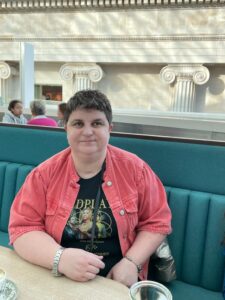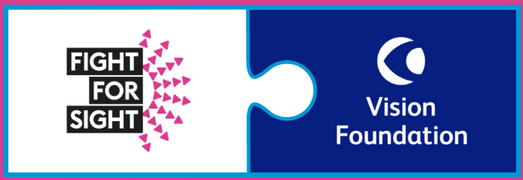Charmaine Ashpole lost her sight suddenly four years ago, and after a long stint in rehab, the arts is what truly brought her back to her self. In this thought-piece Charmaine talks about the role of audio description in arts, culture and society.
 Throughout my life I’ve always been massively into the arts of all kind. Heritage, pop culture, literature, museums, TV, drama and cinema the list goes on. The arts occupy such a beautiful space in all our lives, every one of us.
Throughout my life I’ve always been massively into the arts of all kind. Heritage, pop culture, literature, museums, TV, drama and cinema the list goes on. The arts occupy such a beautiful space in all our lives, every one of us.
I did a BA in English Literature but somehow ended up in the world of procurement which I did for 12 years. By the end of those 12 years I was already spending quite a bit of time evaluating what I was doing with my life and career. It took Amy Winehouse’s death on Saturday 23 July 2011 to give me the final push towards my true passion which was pop culture, theatre, literature and all those kinds of things. That Monday I handed in my notice. Not one to rest on my laurels and knowing that the creative industry is where my heart lies, I started a Masters degree in Arts and Heritage Management. I ended up not handing in my dissertation, as the deadline coincided roughly with the birth of my daughter, but I proudly walked away with a post-graduate diploma. Another daughter followed that and then in 2018 I lost my eyesight.
Losing sight, but not losing my passion
I lost my eyesight as a result of an illness over four years ago, I also lost some of my hearing and mobility. It took me a long time to come around to my new way of seeing and being, considering the significant life change I’d encountered. Following my stint in rehabilitation, the arts buoyed me up.
A crucial part of accessibility within the creative industry is audio description. And for anyone who is sighted or unfamiliar with access and inclusion you wouldn’t be blamed for thinking the arts are off the menu for someone with sight loss. But it couldn’t be further from reality. I could not agree more with Joanna Wood, Chair of VocalEyes (an organisation which supports arts and heritage venues with audio description, training, consultancy and advice) when following her first audio described theatre performance after losing her sight, she said: ‘I felt like a whole person for the first time in three years — it was transformative’.
As an avid theatre-goer I’m well-tuned to when audio description is done well, it is, as Joanna says, transformative. Full access theatre performances will include a mix of, or all of the following:
- Introductory notes which can be about 10-12 minutes long. Available in text and audio. In some cases, there’s a live version just before the start of the performance which also gives audience members a chance to test their receivers.
- A touch tour.
- Thorough description played into a receiver as the performance happens.
And what is particularly important about the above is that this is done by a real person, not a simplified robotic voice, which makes a huge difference. The Introductory notes set the scene, include detailed descriptions of the cast, who plays which character, the stage setting, costumes, etc. Anything that puts the VI audience members on level footing with non-VI audience members. This is a specialist area and so it should be. Theatres which take access and inclusion seriously work with AD specialists, such as Roz Chalmers, a freelance Audio Describer who has described performances for The National Theatre and Old Vic. The skill lies within describing what a blind person can’t see without interpreting the performance word for word, because that audience member can do that for themselves. The Audio Describer will work closely with stage managers and the production team to identify significant props, as well as watch the production to take extensive notes on the appearance of characters and their costumes.
Herein lies the absolute pinnacle of accessibility: that it simply cannot be added on as an afterthought, it must be factored into the creative process from the very beginning.
Audio description isn’t a new concept, and it has started to take a foothold in the wider world. Spreading from guided museum tours to television, but like most of the creative industry it’s taken a huge hit by the Pandemic. But as the Pandemic unravelled the world, it is also giving us the opportunity to rebuild a fairer and more inclusive society. To me Audio Description not only brings life back to people who are visually impaired, but it is a catalyst for conversations about equality, diversity and inclusion that mainstream society should be having in order for everyone to feel valued and a part of society.
I’m a huge believer in positive reinforcement and celebrating where things are going right, so with this in mind here are a few shout outs, further readings as well as a few tips which I have found very helpful, but you may not have come across yet.
Thank you to …
I would like to thank the following people who have taken me on this journey of the ins and outs of Audio Description:
- Roz Chalmers
- Dr Rachel Hutchinson
- Prof Hannah Thompson
- Matthew Cock, Chief Executive of VocalEyes
- Jonathan Penny, ITV
Getting over the threshold …
As someone who is blind I have physically and metaphorically crossed the threshold, these resources have contributed phenomenally to me accessing arts and culture:
- CEA card. You won’t get a discounted ticket but with this card you can get a free ticket for the person accompanying you to the cinema. My extra top tip: if you split the ticket between you, you both get a discount! Find out how to get your card here.
- You are entitled to 2 for 1 tickets at the theatre, but there is no official card like you can get with the cinema. LW Theatre Group have an excellent Access programme so do ask for what you need.
Further reading and listening
Podcast: ITV Drama Takes Audio Description To The Next Level
RNIB Connect Radio’s Allan Russell spoke to ITV’s Jonathan Penny to find out more about a new AD addition to a brand new ITV drama. This podcast is six minutes long and a quick and in depth jump into ITV’s audio description work on Trigger Point. Listen now.
Podcast: Blind guy talks tech – ITV Offers Blind Viewers Unique Insight Into Trigger Point Drama
In this podcast Steven talks to Jonathan Penny, ITV’s AD production manager about Trigger Point’s Meet the Character feature. A unique experience for blind and partially sighted viewers to get to know the characters and what they’re wearing. This was following a request from the channel’s audio description user forum. I highly recommend giving the episode, which is 29 minutes long, a listen as well as the above podcast. Listen now.
Creative Majority report
Research produced with academics from King’s College London and the University of Edinburgh. Creative Majority brings together the best evidence of effective equality, diversity and inclusion practices with the aim to rebuilding the creative industry without the barriers that existed before Covid struck. You can download and read the report here. Please note this is a PDF link, we are sourcing this report in alternative formats.
Describing Diversity: Royal Holloway, University of London
The university establishes its world-class research using four themes, one of which is Digital Futures in the Creative and Cultural Industries. This has led to research exploring how we can ensure that technology is best utilised in the creative industry. The report Describing Diversity by Professor Hannah Thompson, Dr Rachel Hutchinson and VocalEyes was released in September 2020 and has been credited by ITV with influencing their new audio description policy. Download and read the report here. Please note this is a PDF link, we are sourcing this report in alternative formats.
Devisualising the museum: Royal Holloway, University of London
Another incredible piece of work from Prof Hannah Thompson. This report explores audio description in museums and how with VocalEyes this can be enhanced to be subjective and a personal experience for any audience member, whether sighted or blind. You can read about the submitted paper here.
FutureLearn: Creating Audio Description: Equality, Diversity and Inclusion
This free course on the learning platform FutureLearn, explores how to design and create audio descriptions and audio introductions that fully represent a film, play, or TV programme. The course can be accessed and taken at any time, but the creators of the course: Dr Rachel Hutchinson and Prof Hannah Thompson are only present on the course at certain times. Check out the sign up page to find out more.
Let’s keep sharing positive stories! If you come across anything that deserves to be shared let us know by email on media@visionfoundation.org.uk

